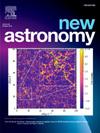在ParaSOL合成跟踪项目中,INT、KASI和T80S望远镜观测到的euroonear NEA小型巡天很少
IF 2.1
4区 物理与天体物理
Q2 ASTRONOMY & ASTROPHYSICS
引用次数: 0
摘要
现代合成跟踪技术(ST)在有GPU计算资源的情况下,可以利用中小型望远镜任意移动和共同添加同一测量场的更多图像,从而探测到比传统闪烁方法更微弱的小行星。在罗马尼亚ParaSOL项目的框架下,我们开发并测试了一种创新的ST算法,该算法能够近实时地探测非常微弱的近地小行星(NEAs),这可能成为欧洲开发的第一个ST管道。为了测试我们的管道,我们使用三个大视场望远镜进行了几次小型调查,即ING的INT,韩国的KASI和巴西的T80S望远镜。大多数图像使用我们的雨伞图像处理管道(IPP)模块进行处理。ST搜索使用我们的合成跟踪通过Umbrella (STU)模块和商业Tycho Tracker软件进行,可以比较和补充发现。源代码验证由使用我们新的Webrella平台的reducer支持。大多数夜晚都是接近实时的,显示了处理、排序和报告大量数据的能力。我们发现了5颗超新星和4颗一夜小行星,共同发现了另外3颗小行星,并恢复了3颗鲜为人知的小行星。我们标记了59个候选近地天体进行恢复和轨道分类,发现、共同发现和恢复了其他18个与轨道相关的近地天体,另外改进了23,428个已知小行星的轨道,并报告了1,374个未知天体。使用新的EURONEAR工具MagLim对ST和传统的眨眼检测进行比较,显示出两个数量级的改进和检测数量的两倍增加。对STU和第谷的初步比较表明,STU探测到第谷的70%左右,但STU探测到快速物体的速度要比第谷快得多,7个速度在2-10英寸/分钟之间的近地天体仅被STU发现。根据我们的调查,我们使用1-2米级望远镜和ST方法评估了目前NEA的发现率,发现每9-12平方度可以发现一个NEA候选者,直到23等。本文章由计算机程序翻译,如有差异,请以英文原文为准。
Few EURONEAR NEA mini-surveys observed with the INT, KASI and T80S telescopes during the ParaSOL synthetic tracking project
The modern synthetic tracking technique (ST) can make use of small and medium-sized telescopes to detect asteroids fainter than the classic blinking methods, by arbitrary shifting and co-adding more images of the same survey field, if GPU computing resources are available. In the framework of the Romanian ParaSOL project, we developed and tested an innovative ST algorithm capable of detecting in near-real-time very faint near-Earth asteroids (NEAs), which likely became the first ST pipeline developed in Europe. To test our pipeline, we conducted several mini-surveys using three large-field telescopes, namely the ING’s INT, the Korean KASI and the Brazilian T80S telescopes. Most images were processed using our Umbrella Image Processing Pipeline (IPP) module. The ST search was conducted using our Synthetic Tracking via Umbrella (STU) module and the commercial Tycho Tracker software, which allowed to compare and complement the findings. The source validation was supported by reducers using our new Webrella platform. Most of the nights were reduced in near-real-time, demonstrating the ability to process, sort, and report large volumes of data. We discovered 5 credited and 4 one-night NEAs, co-discovered other 3 NEAs and recovered 3 poorly known NEAs. We flagged 59 NEA candidates for recovery and orbital classification, discovering, co-discovering and recovering other 18 orbitally related NEAs, additionally improving the orbits of 23,428 known asteroids and reporting 1,374 unknown objects. A comparison between ST and traditional blinking detection using the new EURONEAR tool MagLim shows improvements of two magnitudes and a two-fold increase in the number of detections. A preliminary comparison between STU and Tycho shows that STU detects about 70% of Tycho findings, however STU detects rapid objects much faster than Tycho, 7 NEAs with speeds between 2-10/min being found exclusively by STU. Based on our surveys, we assessed the current NEA discovery rate using 1-2-m class telescopes and ST methods, finding that one NEA candidate can be discovered in every 9-12 square degrees up to magnitude .
求助全文
通过发布文献求助,成功后即可免费获取论文全文。
去求助
来源期刊

New Astronomy
地学天文-天文与天体物理
CiteScore
4.00
自引率
10.00%
发文量
109
审稿时长
13.6 weeks
期刊介绍:
New Astronomy publishes articles in all fields of astronomy and astrophysics, with a particular focus on computational astronomy: mathematical and astronomy techniques and methodology, simulations, modelling and numerical results and computational techniques in instrumentation.
New Astronomy includes full length research articles and review articles. The journal covers solar, stellar, galactic and extragalactic astronomy and astrophysics. It reports on original research in all wavelength bands, ranging from radio to gamma-ray.
 求助内容:
求助内容: 应助结果提醒方式:
应助结果提醒方式:


